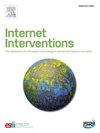基于网络的多模态情绪识别训练在有自闭症和无自闭症青少年中的可行性:一项试点研究
IF 4.1
2区 医学
Q1 HEALTH CARE SCIENCES & SERVICES
Internet Interventions-The Application of Information Technology in Mental and Behavioural Health
Pub Date : 2025-07-10
DOI:10.1016/j.invent.2025.100861
引用次数: 0
摘要
研究表明,患有自闭症谱系障碍(ASD)的个体在情绪识别(ER)方面存在困难,这可能导致社交困难。内源性休克可通过有针对性的干预措施得到增强,但将其推广到日常功能则是一个挑战。在训练中使用动态多模态情绪表达可能会增加与日常情况的相似性。本初步研究探讨了基于互联网的多模态情绪识别训练(iMERAT)对青少年ASD的可行性。方法8名ASD青少年和9名典型发育(TD)青少年参加了iMERAT干预,其中包括在3周内每个工作日进行的简短在线培训课程。对动态面部、声音和多模态情绪表达进行训练,并在每次反应后提供结果反馈。我们进行了一项调查,以探讨参与者的培训经验。使用多模态ER测试测量训练前和训练后的ER。结果参与者反映培训难度适中,指导内容相对容易理解,培训时间适当。开放式回答的内容分析建议进一步调整,例如提供更多的情绪解释,并进一步为青少年量身定制内容和语言。从干预前到干预后,ER增加了,对ASD和TD青少年都有很大的效应量。结论iMERAT干预青少年ASD是可行的。研究人员观察到了内质反应能力的提高,但样本量小,缺乏对照组,因此这些发现是初步的。需要进一步的研究来评估iMERAT的有效性以及对更广泛的社交技能可能产生的影响。本文章由计算机程序翻译,如有差异,请以英文原文为准。
Feasibility of internet-based multimodal emotion recognition training in adolescents with and without autism: A pilot study
Background
Research suggests that individuals with autism spectrum disorder (ASD) have difficulties in emotion recognition (ER), which could lead to social difficulties. ER can be enhanced through targeted interventions, but generalization to everyday functioning poses a challenge. Using dynamic multimodal emotional expressions for training may increase similarities to everyday situations. This pilot study investigated the feasibility of internet-based multimodal emotion recognition training (iMERAT) for adolescents with ASD.
Method
Eight adolescents with ASD and nine typically developing (TD) adolescents took part in the iMERAT intervention, which included brief online training sessions conducted each weekday during a 3-week period. Training was performed on dynamic facial, vocal and multimodal emotional expressions, with outcome feedback provided after each response. A survey was conducted to explore participants' experiences of the training. ER was measured pre- and post-training using a multimodal ER test.
Results
Participants reported that the training was moderately difficult, instructions were relatively easy to understand, and the duration of training was appropriate. Content analysis of open-ended responses suggested further adaptations, such as providing more explanations of emotions and further tailoring content and language for adolescents. ER increased from pre- to post-intervention, with large effect sizes for both ASD and TD adolescents.
Conclusion
Results suggest that the iMERAT intervention is feasible for adolescents with ASD. Gains in ER ability were observed, but the small sample size and lack of a control group render these findings tentative. Further research is required to assess the effectiveness of the iMERAT and possible impact on broader social skills.
求助全文
通过发布文献求助,成功后即可免费获取论文全文。
去求助
来源期刊

Internet Interventions-The Application of Information Technology in Mental and Behavioural Health
Medicine-Health Informatics
CiteScore
6.50
自引率
9.30%
发文量
94
审稿时长
6 weeks
期刊介绍:
Official Journal of the European Society for Research on Internet Interventions (ESRII) and the International Society for Research on Internet Interventions (ISRII).
The aim of Internet Interventions is to publish scientific, peer-reviewed, high-impact research on Internet interventions and related areas.
Internet Interventions welcomes papers on the following subjects:
• Intervention studies targeting the promotion of mental health and featuring the Internet and/or technologies using the Internet as an underlying technology, e.g. computers, smartphone devices, tablets, sensors
• Implementation and dissemination of Internet interventions
• Integration of Internet interventions into existing systems of care
• Descriptions of development and deployment infrastructures
• Internet intervention methodology and theory papers
• Internet-based epidemiology
• Descriptions of new Internet-based technologies and experiments with clinical applications
• Economics of internet interventions (cost-effectiveness)
• Health care policy and Internet interventions
• The role of culture in Internet intervention
• Internet psychometrics
• Ethical issues pertaining to Internet interventions and measurements
• Human-computer interaction and usability research with clinical implications
• Systematic reviews and meta-analysis on Internet interventions
 求助内容:
求助内容: 应助结果提醒方式:
应助结果提醒方式:


